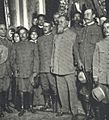Casasola Archive facts for kids
The Casasola Archive is a huge collection of photographs that show the history and culture of Mexico. It's like a giant photo album for the whole country! This amazing collection is the main part of Mexico's National Photo Library, which is managed by the Mexican government. The archive holds very important historical pictures from the time of Porfirio Diaz and the exciting period of the Mexican Revolution.
Contents
The Casasola Archive: A Window to Mexico's Past
What is the Casasola Archive?
The Casasola Archive was put together by Agustín Víctor Casasola, who was a photojournalist in Mexico City. It includes his own photos and pictures taken by about 500 other photographers. The collection has both printed photos and the original negative films, in many different sizes and types.
Since 1976, this special archive has been kept safe in rooms with controlled temperatures. These rooms are inside an old Franciscan convent, which is now the National Photo Library. This library is part of the National Institute of Anthropology and History (INAH) in Pachuca, Hidalgo, Mexico. The building not only stores the photos but also has spaces where they can be shown to the public. Today, the photo library has 39 different sections, with a total of 850,000 items, including both positive prints and negatives.
How the Archive Began
Agustín Víctor Casasola (who lived from 1874 to 1938) and his brother Miguel (1876–1951) were among the first people to take news photos in Mexico. They took many pictures during the Mexican Revolution. They sold copies of their photos, but they kept the original negatives. This is how Agustín Víctor started the archive.
After Agustín Víctor, his children continued to build the collection. These included Gustavo, Agustín, Ismael, Dolores, Piedad, and Mario. Other famous photographers whose work is part of this collection are Guillermo Kahlo (who was the father of the artist Frida Kahlo), Hugo Brehme, Manuel Ramos, Eduardo Salmerón, Samuel Tinoco, and F.L. Clarke.
What You Can Find in the Archive
Most of the photos in the Casasola Archive were taken in Mexico City, where the Casasola family lived and worked. Many pictures show politicians and important political events. But the archive also has many photos of everyday life. You can see scenes of factories, transportation, city growth, and even advertisements. There are also pictures of sports, arts, entertainment, and portraits of people who lived in the capital city.
Protecting Mexico's History
The Casasola family owned the archive until 1975. There was a chance that the collection might be sold and taken out of Mexico. The Mexican government understood how important these photos were to the country's history and culture. So, they bought the entire collection to keep it safe in Mexico.
The National Institute of Anthropology and History (INAH) now manages the archive through its National Photo Library. The old San Francisco convent in Pachuca, Hidalgo was updated with special climate control systems. The facility officially opened on November 20, 1976. This date is special because it's the anniversary of the start of the Mexican Revolution. The archive has been there ever since.
The Casasola Archive at the National Photo Library has 483,993 pieces. This includes 411,904 negatives (many are old glass plates and nitrate films) and 72,089 printed photos. About 43% of these photos have been digitized. This means they are available to view online through the National Photo Library System's catalog.
Gallery
-
Arrival of Francisco I. Madero at Pachuca
-
The victory at Ciudad Juárez Venustiano Carranza, Francisco I. Madero, Pascual Orozco, Francisco Villa 1911.
-
Ten Tragic Days February 1913
-
Venustiano Carranza and General Álvaro Obregón.
See also
 In Spanish: Archivo Casasola para niños
In Spanish: Archivo Casasola para niños









